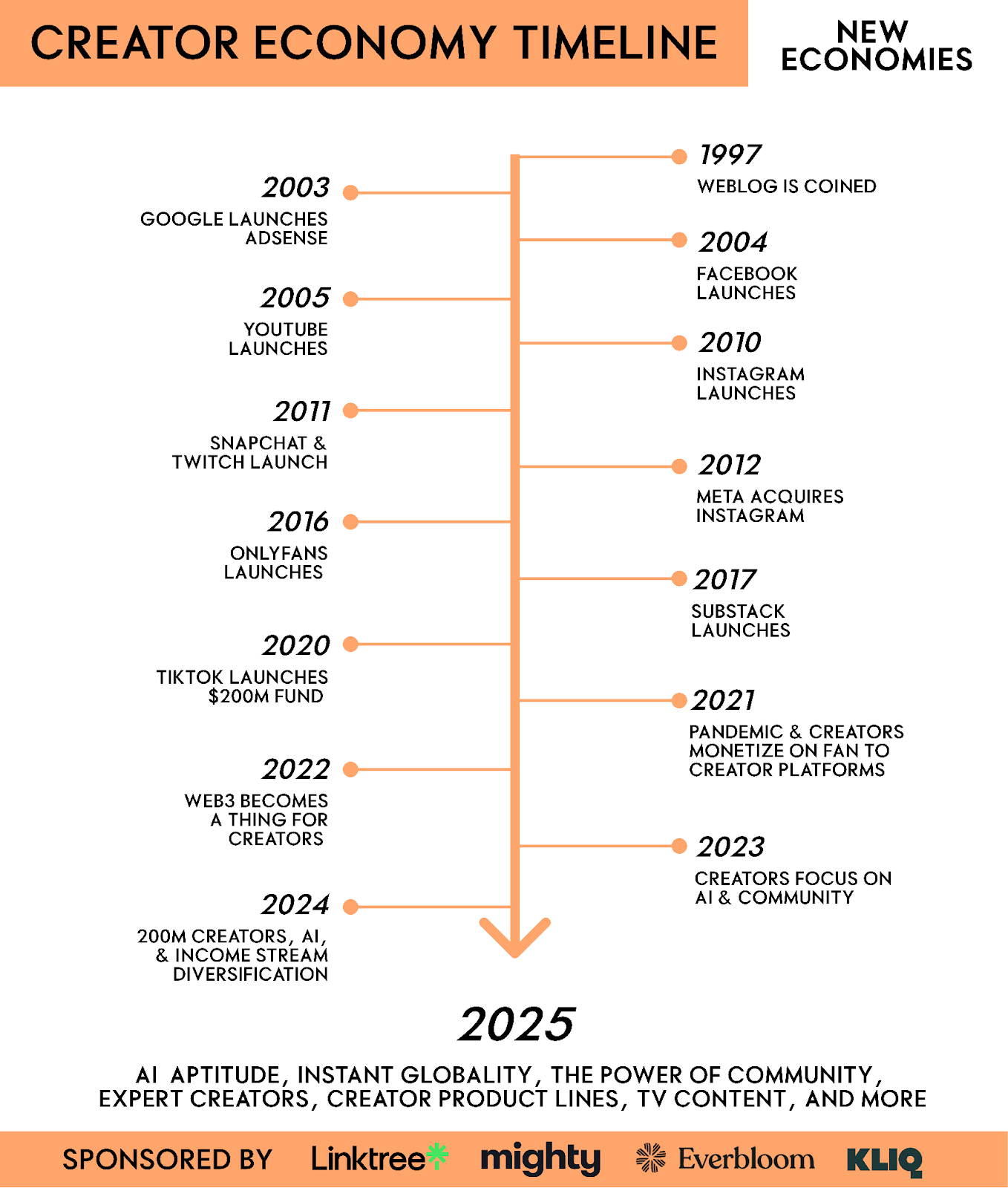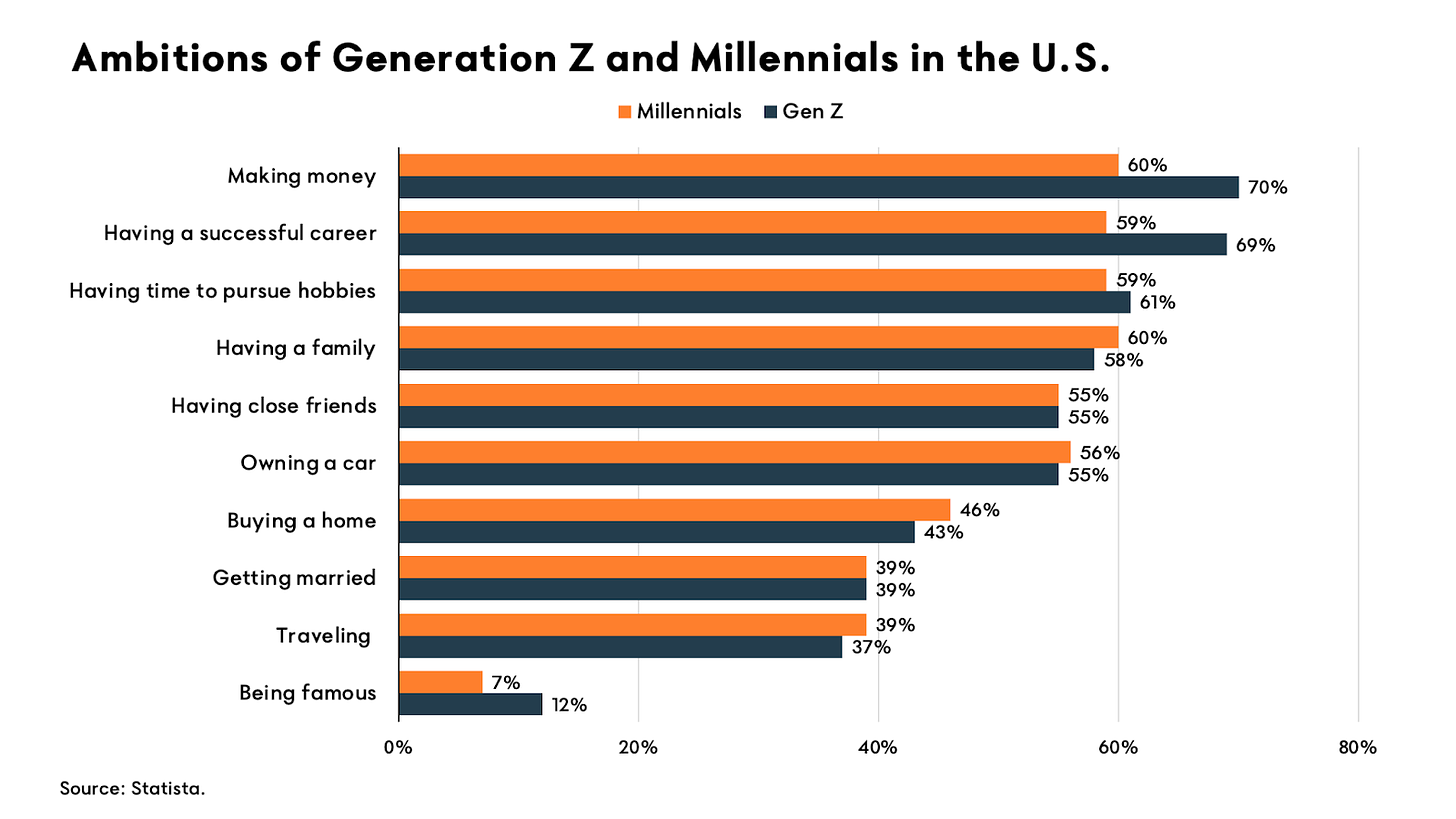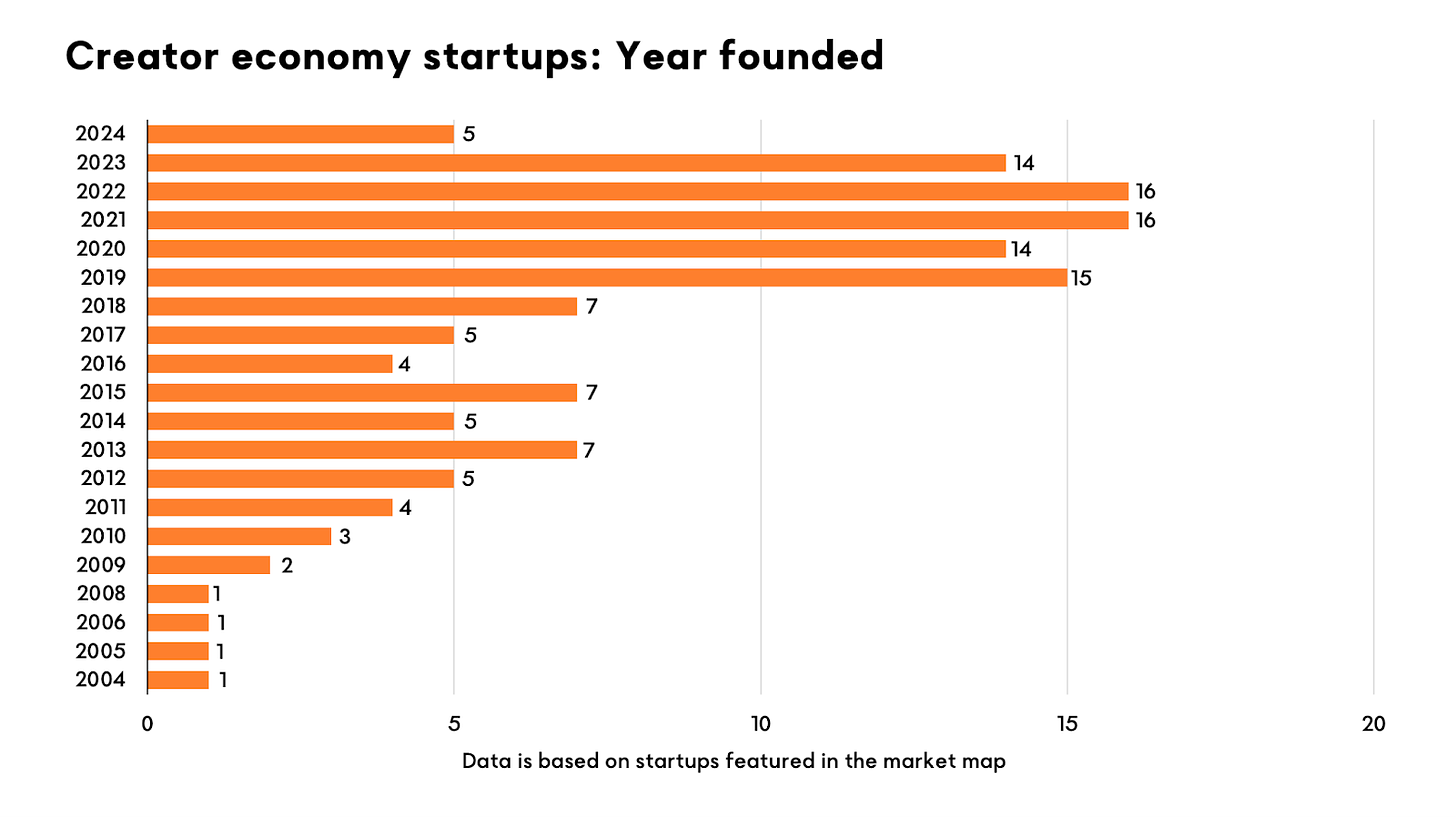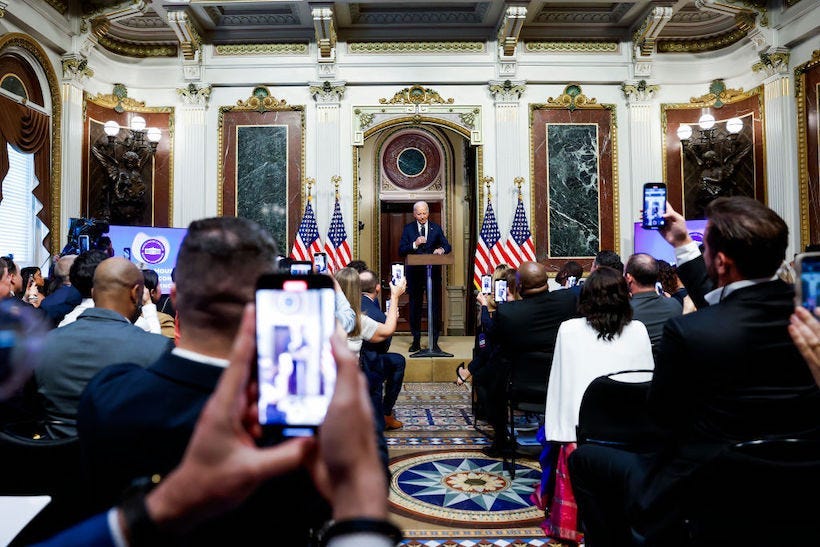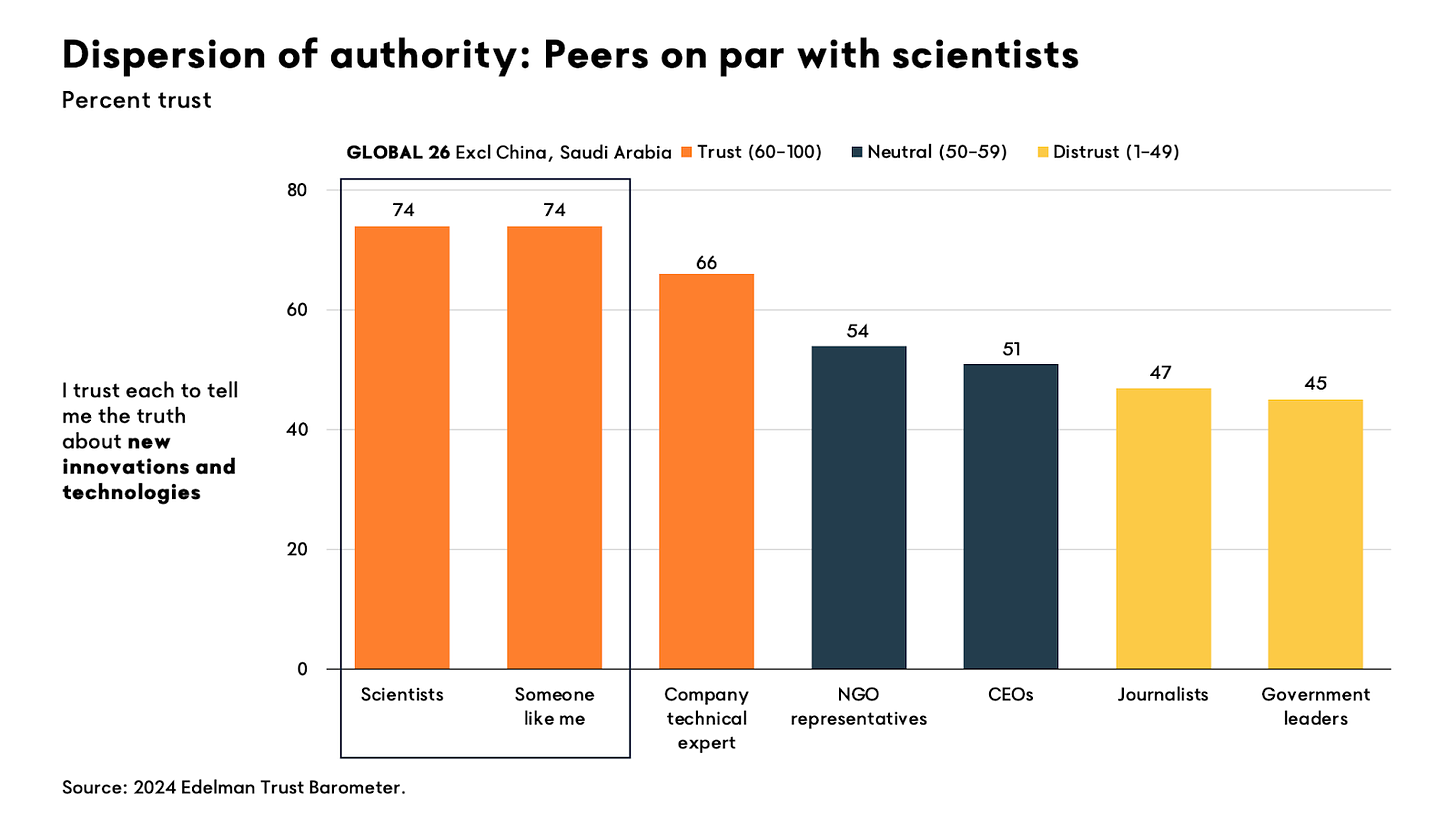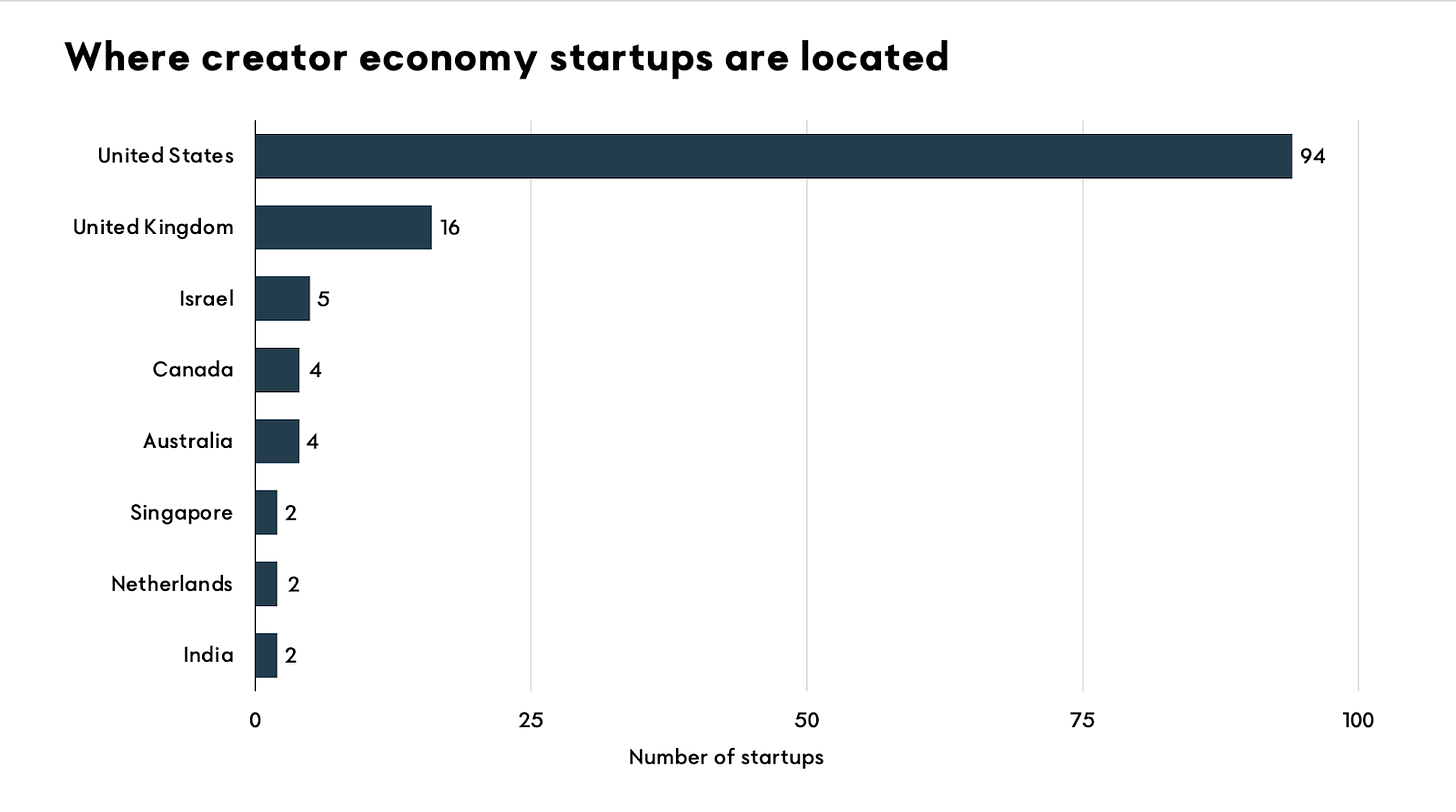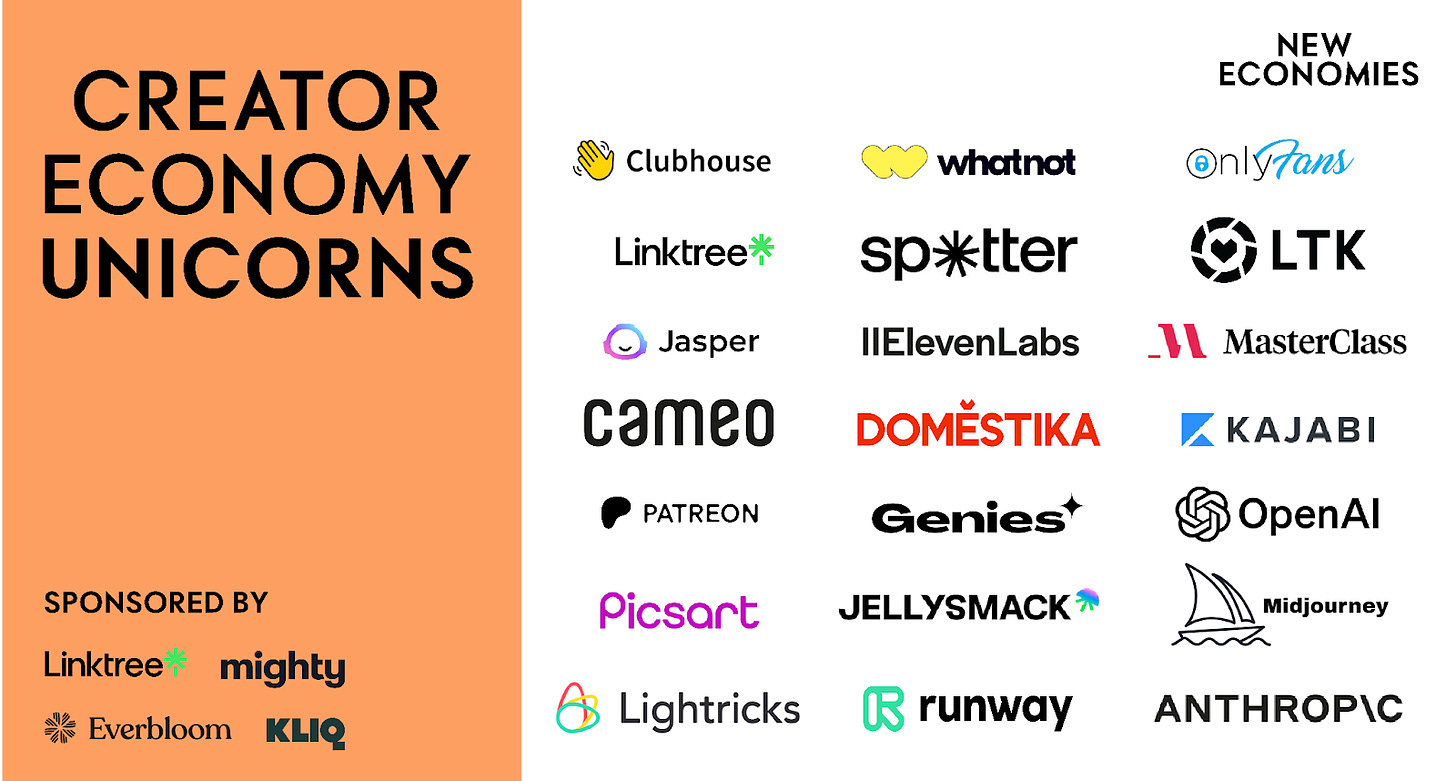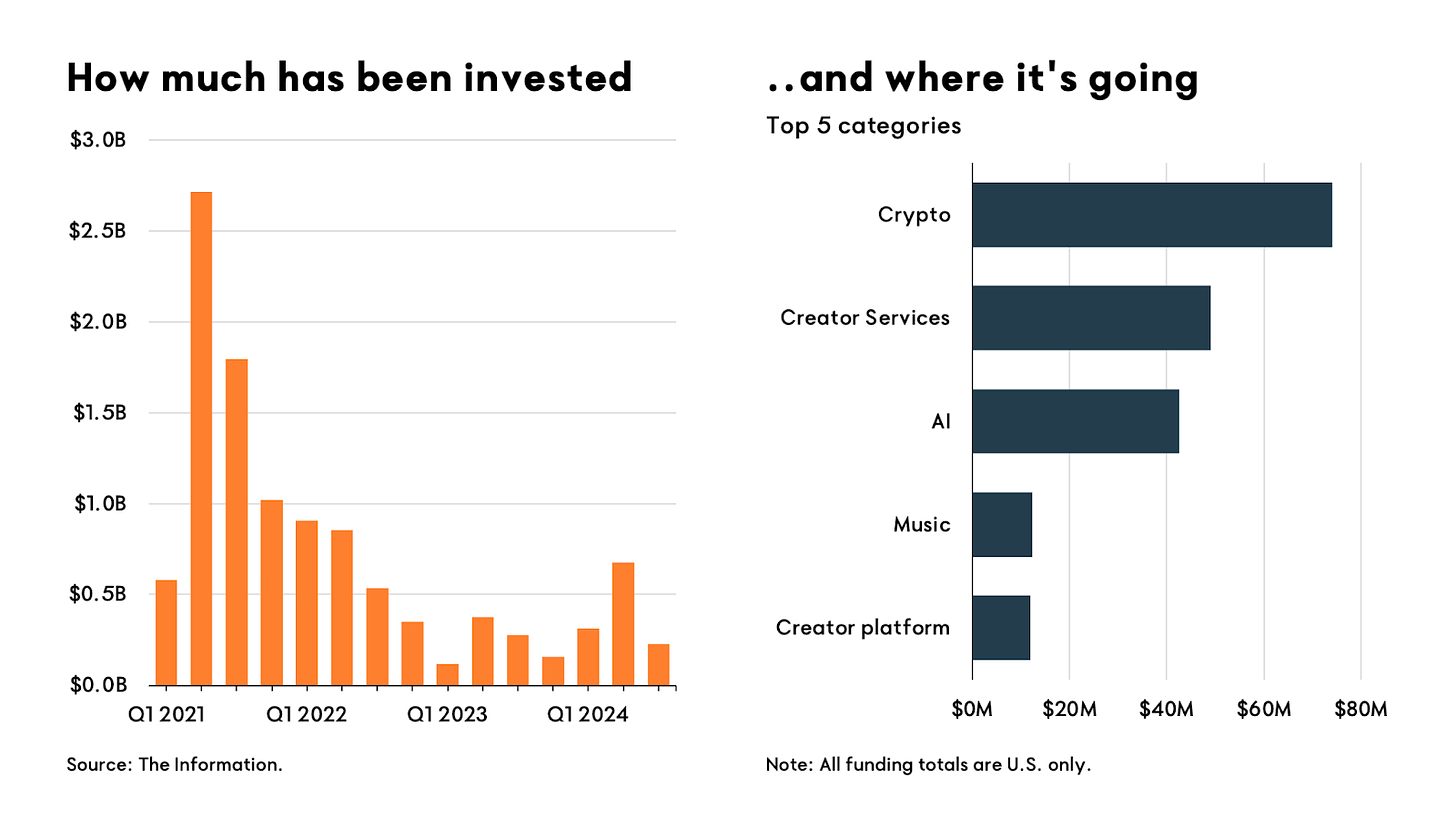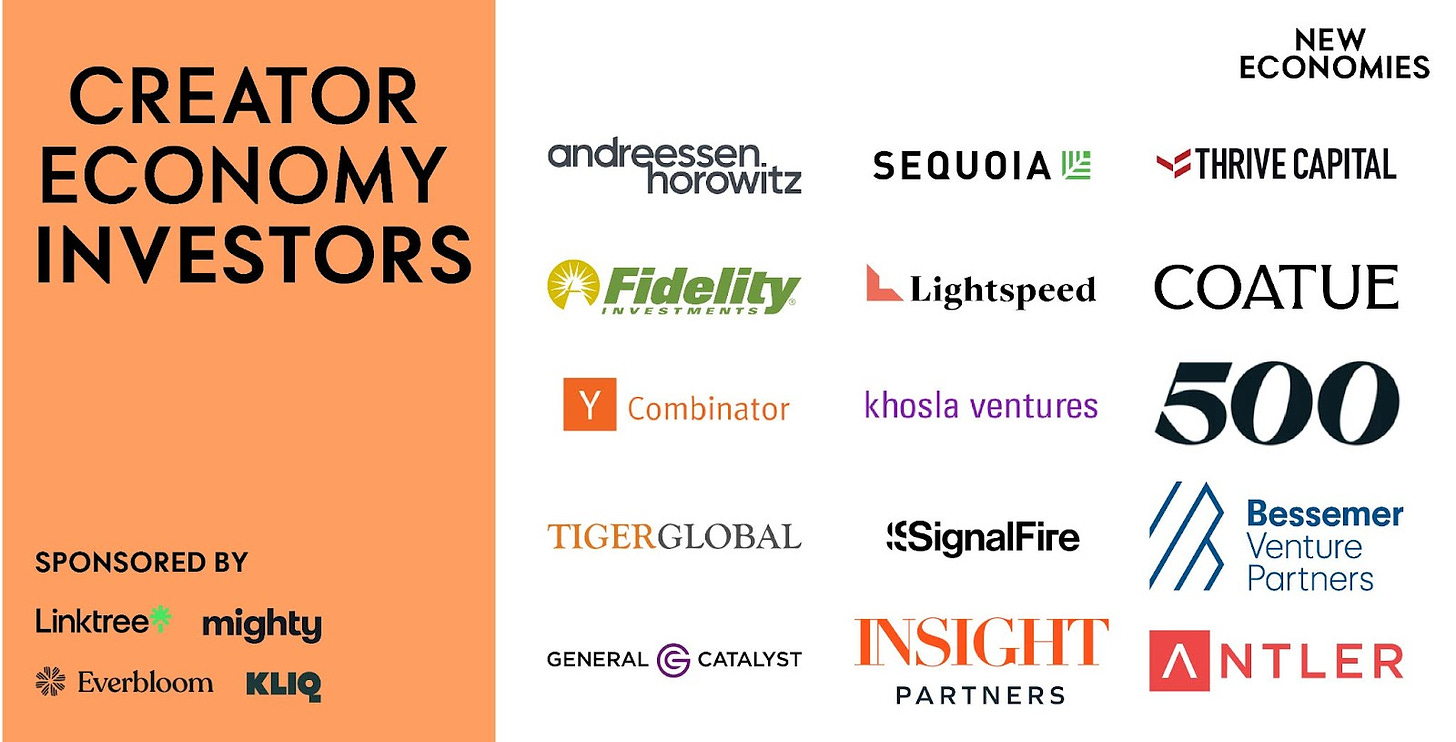Hey Readers 👋
My name is Ollie Forsyth founder of New Economies. Each year, I publish an annual creator economy report, discovering what is happening across the creator ecosystem and what we should expect next. Today, I’m excited to be releasing this year’s edition with you.
Three years ago, when I published the first ultimate guide on the creator economy, the category was booming at an unprecedented speed of growth. In 2021, there was a rise in platforms allowing creators to monetize, partly driven by the COVID-19 pandemic prompting thousands to find alternate ways to make an income. To benchmark the success of creator economy companies in 2021, a record 11 companies reached unicorn status that year.
In 2022, the creator economy charted new territory and entered Web3, with a surge of more transparent creator-to-fan platforms handing more power to the creator. A number of platforms pivoted or launched services that enabled creators to issue NFTs, tokens, or crypto-related assets, which we mapped in the 2022 report.
In 2023, the creator economy shifted once again with the rise of Generative AI (Gen AI) tools, paired with the growing focus on community, as highlighted in last year’s report. The dominance of AI and community has persisted throughout 2024. Will the same trend continue in 2025?
Welcome to our 2025 Creator Economy Report, the fourth annual in-depth analysis of one of the most exciting sectors, including: key trends for the year ahead, the impact of AI, challenges and opportunities for creators to keep top of mind, the evolution of the startup landscape, and the big question on many minds—where will the creator economy go next?
In this year's edition, you will discover:
Chapter 1: What is the creator economy?
Chapter 2: The creator landscape today.
Chapter 3: The 180+ creator startups to watch.
Chapter 4: The fundraising and unicorn landscape.
Chapter 5: AI: The big creator game-changer.
Chapter 6: Challenges for creators in 2025.
Chapter 7: The new creator economy: 2025 trends.
Chapter 8: The top ways creators can thrive in 2025.
Chapter 9: Is the creator economy here to stay?
This year’s edition is brought to you by Linktree, Mighty Networks, Everbloom, and KLIQ. A big thank you for powering this report.
Chapter 1: What is the creator economy?
The creator economy is the widely growing ecosystem of over 200 million creators who are monetizing their individuality in myriad ways. These creators range from people producing content on platforms like Instagram, Meta, OnlyFans, TikTok, Twitch, and X to those launching paid communities or courses on platforms like Mighty Networks and KLIQ. Creators also choose to monetize their passions by building communities, while others focus on niche hobbies like creating Japanese art or crafting Turkish pottery.
In just a few years, the number of creators has surged from 50 million to 200 million-plus worldwide—and it's expected to keep growing with 70% of Gen Z aiming to become creators as their preferred career choice. The creator market size is expected to double by 2027. Anyone can become a creator, and if you haven't already tried, there has never been a better time to give it a go.
Chapter 2: The creator landscape
In recent years, the creator economy has experienced its share of highs and lows—including its peak during the COVID-19 pandemic and lows like widespread creator burnout, platforms taking large take rates from creators, and a new challenge that’s now top of mind for many: how can AI safeguard content? Amidst those pressing questions and challenges, the focus for creators is clear as we head towards 2025 and beyond: AI, community, and diversifying revenue streams.
These three big themes are fueling big growth.
The number of people becoming creators continues to hit new highs. We believe that in the future, most of us will take on the role of creators—whether as a full-time career or alongside our day-to-day jobs. It’s rapidly becoming the career of choice for many Gen Zers, who prioritize financial independence and entrepreneurial ambition. As we explored in a recent newsletter on how Gen Z is shaping the future, this generation is redefining career paths and influencing the next wave of creators.
“As we go into 2025, I see a trend where creators can create the equivalent of their own TV channels. Meaning creators have the ability to offer the same as a TV channel does. We have an audience that a lot of TV channels wish they had. As creators we can command proper payment for our work but also be the creator, agency, and broadcaster for brands if we wish to.’’
—Simon Squibb, creator.
What’s changed in the last 12 months?
Over the past 12 months, the creator economy has evolved significantly with AI impacting nearly every creator. Creators can now reach a global audience from day one by translating their content into any language using their own voice. A new wave of AI-driven video platforms allows creators to edit their videos into bite-sized clips in minutes, rather than the days it used to take.
In the last report 18 months ago, we predicted creators would become global from day one. This has now become a reality. A year and half ago only 33% of creators were using Gen AI tools. Fast forward to today—a recent report by YouTube reveals 92% of creators are now using Gen AI-related tools with 90% of creators feeling they are not using Gen AI to the fullest extent possible.
Here are more examples of how the creator economy has adapted over the last 12 months:
Fewer startups are building in the creator economy.
This year, we've seen a noticeable decline in the number of new startups building for creators. In contrast to the hundreds of startups that emerged in our previous three editions, this year's count is significantly lower.
Why the slowdown? Startups raised too much capital too quickly.
That being said, a larger percentage of startups featured in the last report are still operational versus those featured over the past three years. Does this suggest there’s still untapped innovation and opportunities in the creator space? Absolutely—if you prioritize supporting creators with discoverability and revenue generating opportunities.
“Consolidation, mostly by elimination rather than by acquisition. Many startups have and will shut down, which is a good thing! There were way too many. Those that persist and survive will find themselves in a much healthier environment—less competition, more opportunity.”
–Gagan Biyani, co-founder of Maven.
Creators gained presidential attention.
The creator economy even made its way to The White House. The White House’s Office of Digital Strategy hosted its first-ever creator economy event in August, convening 100 digital creators, startups, platforms, and influencers to discuss pressing issues within the creator economy today—from privacy and fair pay to AI and mental health.
The appeal of alternate information sources is growing.
We’ve seen a huge rise in newsletter writers over the last 12 months. This year’s Edelman Trust Barometer revealed mistrust in journalists is increasing, with 64% of respondents worrying they are purposely trying to mislead people. At the same time, 74% of people trust “someone like me” to tell the truth, on par with scientists. Given today’s environment of mistrust and misinformation, we expect many consumers will continue to be more discerning about who they consume information from and who can be trusted sources of information. Their search for alternate and independent sources will fuel the popularity of newsletters going forward.
“More and more consumers are looking to learn and take information directly from who they consider an expert. There’s never been a better time to create content and educate your audience on your niche knowledge.’’
–Ben Camara, founder of KLIQ.
Creators can go from content production to global distribution in a breeze.
As the originator of the link-in-bio category with a community of over 50 million users, Linktree is the top tool creators and businesses use to curate, grow, and monetize their audience. In August they acquired Plann, a social media scheduling platform. Adding social scheduling to Linktree will make it even easier for busy creators juggling producing content and multiple ventures to distribute inspiring content.
Creators are becoming businesses themselves.
We’ve seen a much larger number of creators over the last 12 months become businesses themselves, launching new brands and figuring out new ways to diversify revenue streams on platforms such as KLIQ. As content creators emerge and develop, they will need to diversify their revenue streams instead of relying on fewer revenue earners. We expect more creators to launch their own product lines and to potentially become software founders themselves. We also anticipate more creators to partner with platforms like Everbloom who help YouTubers level up their channels with upfront funding.
“Platforms need to adopt a creator-first mindset, focusing on empowering creators with the tools they need to take full control of their content, data, and monetization. It’s not enough to provide a space for creators. Equally important is addressing the mental well-being of creators and users. The prevalence of negativity and trolling on social platforms not only impacts individuals but also distracts from the overall experience. Finally, refining algorithms to support organic audience growth is crucial. Creators need fair systems that help them expand their reach.’’
—Amrapali Gan, former CEO at OnlyFans.
Chapter 3: The 180+ creator startups to watch
To help navigate this evolving landscape, we created a market map that highlights 180+ early-stage startups supporting the creator economy, organized in three categories:
Gen AI tools.
Tools that help creators grow and flourish across community, monetization, and everyday support.
Vertical platforms such as gaming and music startups.
Disclaimers:
The startups have been listed based on how they describe themselves on their external websites.
The startups were selected based on our data room (including 5,000+ startups and 2,000 investors, investor and founder recommendations, and market research).
Creator economy startup hot spots.
With hundreds of startups now building, where are they based?
Drilling down on the startups in our market map, the U.S. continues to be the go-to country to launch a startup within the creator economy followed by the U.K. and Israel.
What’s driving this? Most of the notable creator economy platforms are based in the U.S. since a huge number of the most influential creators are living there too, along with most of the investors investing in the category and most of the talent that works for creator-focused platforms and startups.
Chapter 4: The unicorn and fundraising landscape
Although the number of creator-based startups has reduced this year, we have seen a few new unicorns, most of which are AI related. For example, the dubbing software company ElevenLabs was one of the first platforms to reach unicorn status in January 2024 with their $80 million in fresh funding.
Here are some noteworthy data points about the unicorns listed in the infographic below:
The number of creator economy unicorns reached 11 in 2020.
Since 2020, 13 new unicorns have emerged, including: Clubhouse, MasterClass, Cameo, OpenSea, Axie Infinity, Spotter, Linktree, Domestika, Jasper, Runway, Anthropic, ElevenLabs, and OpenAI.
95% of creator-based unicorn platforms are based in the U.S.
46% of the new creator unicorns are AI-based platforms.
The latest trends in creator economy fundraising.
In the first half of 2024, creator economy startups in the U.S. raised roughly as much money as they did in all of 2023, according to The Information.
In the second quarter alone, U.S. creator startups raised $692.7 million, up 68% from a year earlier and more than double the amount raised in the first quarter. Globally, creator startups raised approximately $767.9 million during the period, an increase of roughly 49% year over year.
In the third quarter, funding for U.S. creator economy startups fell nearly 16% year-over-year to $253.1 million.
Investment levels remain far from their peak three years ago. Still, the rebound reflects venture capitalists’ confidence that startups can take advantage of Generative AI to develop the tools and services creators want.
Who’s investing and what are investors expecting next?
Chapter 5: AI—the big creator game-changer
Keep reading with a 7-day free trial
Subscribe to The VC Corner to keep reading this post and get 7 days of free access to the full post archives.




